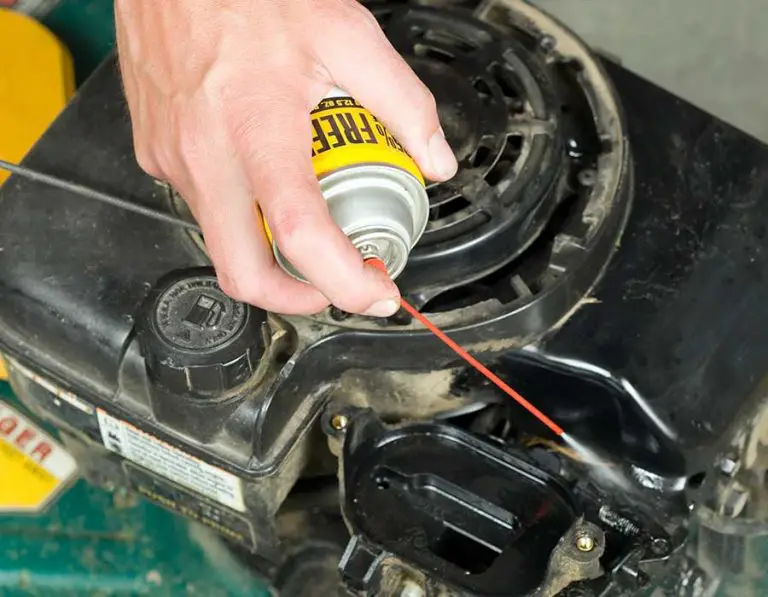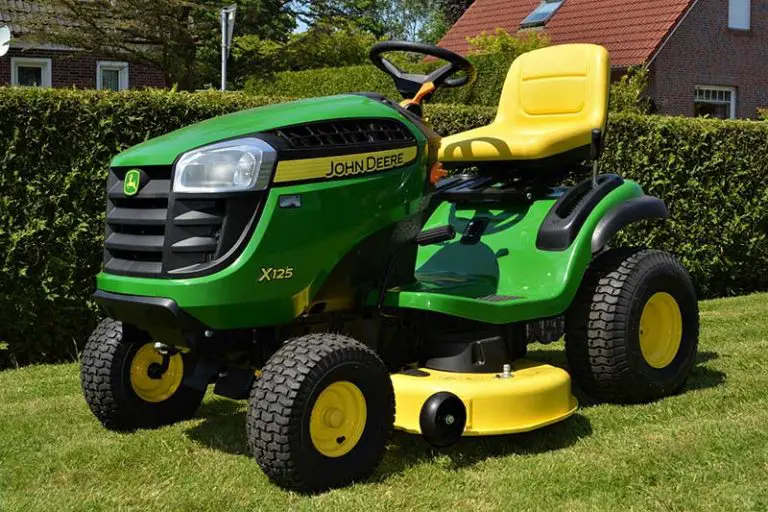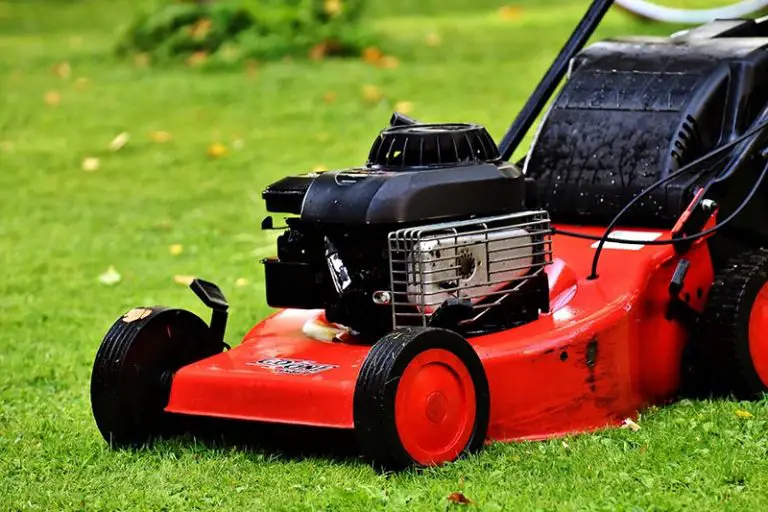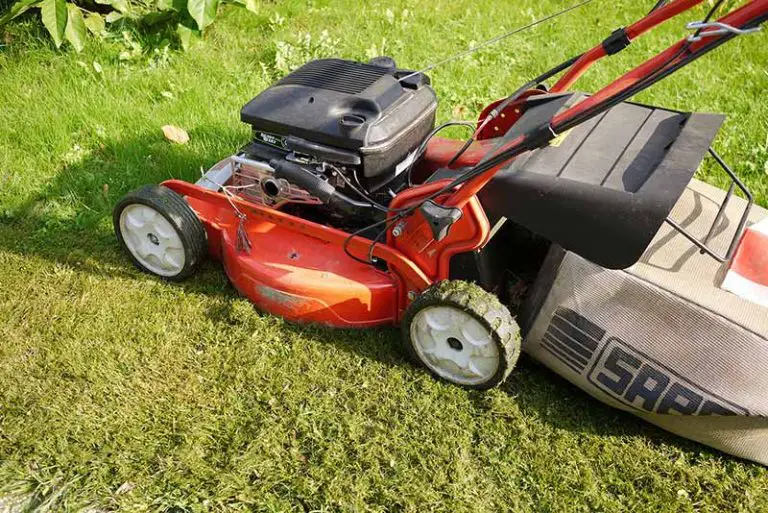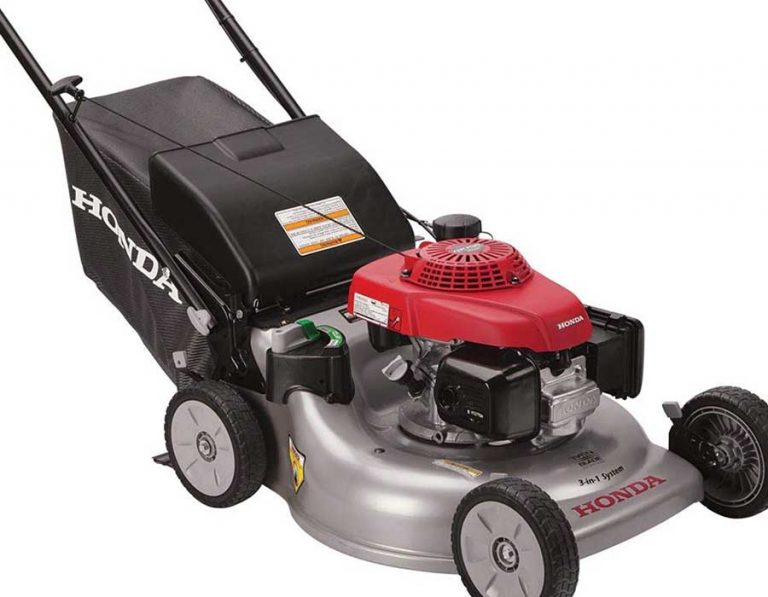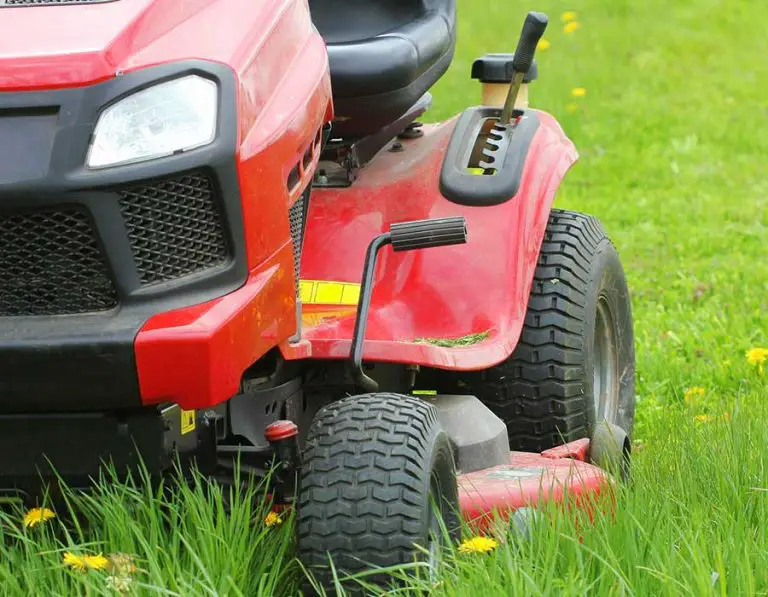How To Stripe A Lawn
If you are tired of the uniform green of your lawn, you may consider giving it a little pizazz by striping your lawn. Have you ever wondered how large sports stadiums achieve the striping effect on their lawns? We are about to give you insider secrets on how to do this on your own lawn and be the envy of your neighbors!
Lawn striping is essentially mowing your lawn with a plan and a purpose. Mowing the lawn in consistent directions will cause the grass to lay over to one side or the other, exposing either the shiny, bright side of the grass leaf or the dull, lighter side, producing patterns in the lawn.
Many gardeners look at striped lawns and wish they could get their lawn looking the same way. They incorrectly assume that special equipment and knowledge beyond their scope is required to get this effect. While you can get all high-tech with your lawn striping, you can get surprisingly good results using the equipment you probably already have!
How To Get Stripes And Patterns In Your Lawn
If you research how to get stripes on your lawn, you will find many resources detailing fancy equipment such as rollers and special addons to lawnmowers to achieve a pattern in your lawn.
While these specialized tools help get a pattern in your grass, they are not absolutely necessary to achieve these effects. Striping your lawn is achievable by anyone, even with basic lawn care equipment.
We will show you how to get a professional-looking pattern finish on your lawn with a little patience and planning. Let’s get down to figuring out how this works, what you will need, and the best way to execute your striping plan.
How Does Lawn Striping Work?
Lawn striping is not trick photography. It is also not done by staining the grass with chemicals or other substances either, but rather an exploitation of the natural characteristics of the grass.
If you pick a blade of grass from your lawn and examine it closely, you will find that one side of the grass is bright green, while the underside of the blade is a lighter grey-green color. We use this difference in color between the two sides of the grass blades to achieve the patterns in the grass.
When the lawn is pushed down in one direction, the shiny, bright green of the leaf faces upwards, and when the lawn is pushed down in the opposite direction, the pale side of the leaf faces upwards. Of course, this is a simplification to explain the basic theory behind lawn striping, and there are some techniques we can use to make this color difference work in our favor and put patterns in our lawn.
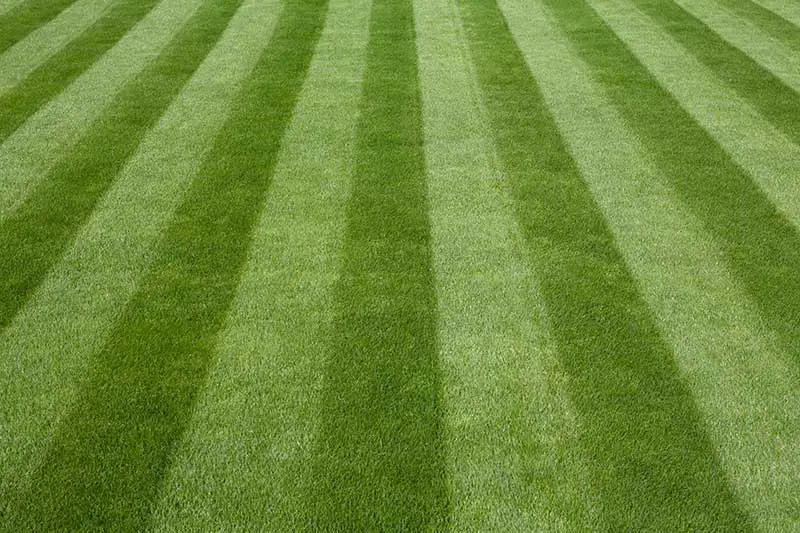
Plan Out Your Lawn Striping
As with any gardening activity, planning is the foundation of success, and striping your lawn is no different in this regard. You need to take the time and survey the lay of your garden and figure out what pattern would go well with your garden layout.
What is of great benefit to your planning is to make a quick sketch of your garden layout and try out a few pattern options to see which one will work best for your garden. The main thing to remember is that if this is your first time striping your lawn, you may want to keep the pattern simple at first before trying something a bit more ambitious.
Tip: If you have curvy garden beds, you may want stripes that follow the curves or diagonals that intersect the curvature of the garden beds. You could stripe your lawn in a checkerboard pattern, diamond pattern, or stick with the old standby of straight stripes.
Once you have a pattern for your lawn in mind, the next part of your planning is to make sure your equipment is in order before you start.
The main piece of equipment you will be using in the striping of your lawn will be your lawnmower. You can use a ride-on mower or a push mower, but you will need to prepare your mower for the task.
If you want to get crisp, definitive lines in your grass, you will need your lawnmower blades to be sharp. A mower that rips the blades of grass rather than cutting them will leave indistinct lines and a less definitive, visually striking pattern in the grass.
Dull lawnmower blades also bruise the leaves of the lawn and can cause the cut grass to turn brown after cutting, effectively destroying your carefully laid out pattern! Follow the guidance in our DIY article How to Sharpen Lawn Mower Blades to sharpen your blades at home. Alternatively, take your lawnmower blades to be professionally sharpened if you are not confident about doing this job yourself.
Make sure the underside of your mower is clean and free from clumped-up grass from your previous mowing exercise. Cleaning these clumps out from the underside of your mower will ensure they do not affect how the lawn is bent over in the mowing process to achieve crisper lines.
Healthy Lawn Is Required For Striping
Can you stripe any lawn, or does your lawn need to be in good condition? A patchy, unhealthy lawn or a lawn cut too short will not offer the desired results for striping.
Before you consider changing the look of your lawn with striping, it should be in a healthy, lush condition. The striping effect is dependant on healthy, long blades of grass that will respond well to being cut and pushed over to reveal the desired patterns.
A struggling or unhealthy lawn will not have the necessary vertical growth or consistency to achieve a desirable or effective pattern.
Instead of striping your lawn, you should rather spend some time and attention on improving the quality and health of the lawn. Lawn aeration and lawn fertilization on a regular schedule will enhance the growth of your grass and prepare it for striping.
Lawn striping can actually benefit the health of your grass as well as increase the visual appeal. Always mowing your lawn in the same direction causes ruts in the grass, resulting in low spots and divots in the grass. In low spots in the lawn, longer grass shads out the grass below, causing it to die, presenting as brown sections in the lawn.
Alternating the direction helps reduce this rutting effect and promotes a more even look to the grass and a healthier lawn. The healthier the lawn, the easier it will be to stripe.
Does The Type Of Grass Matter For Lawn Striping?
The type of lawn does play a role in the effectiveness of the striping. Grasses that have naturally longer, more flexible leaf blades will bend over more easily than lawn varieties with shorter leaf structures.
Lawns varieties for cool regions such as Kentucky Bluegrass and Fine Fescue will produce better striping effects than grasses such as St Augustine, which are better in warm regions.
You should be able to get a striping effect on most lawn types, but you need to be aware that the type of grass will affect the visual impact of the striping.
How To Stripe Your Lawn With A Lawnmower
Now that you have the basics in place and your equipment in order, it is time to start the process of getting those patterns established in your lawn.
The principle behind the process is fairly straightforward, but you need to focus on details to create the correct impression.
Mowing Height For Striping Your Lawn
If your usual lawn mowing strategy is to mow the grass short to reduce the time between mowing, you will need to adjust your methods for effective striping.
You will need to give your lawn time to grow longer than you would normally before retrieving the mower from the shed and plowing through the grass. As we said in the beginning, this takes planning and preparation.
For the best lawn striping results, you need to take a higher cut in your lawn to allow for longer leaf blades on the grass that can be bent over more easily and remain in this position longer for a long-lasting pattern.
Short-cut grass is stiff and reluctant to bend and will bounce back to the vertical position very quickly. This will make the initial pattern faint and indistinct and reduce how long the pattern will remain in the grass.
Mowing your lawn higher is not only good for striping but also promotes a healthier lawn. Cutting lawn short traumatizes the grass and limits its ability to photosynthesize and effectively use nutrients. The ideal height to cut your lawn for better striping and better health for your lawn is 3.5-inches.
Longer leaves on the lawn act as a natural mulch; they help retain moisture in the grass and in the soil beneath the grass, keeping the grass healthy and allowing the grass to stan bent over for a longer period. Dry grass is stiff and inflexible and will not retain the striping effect for long.
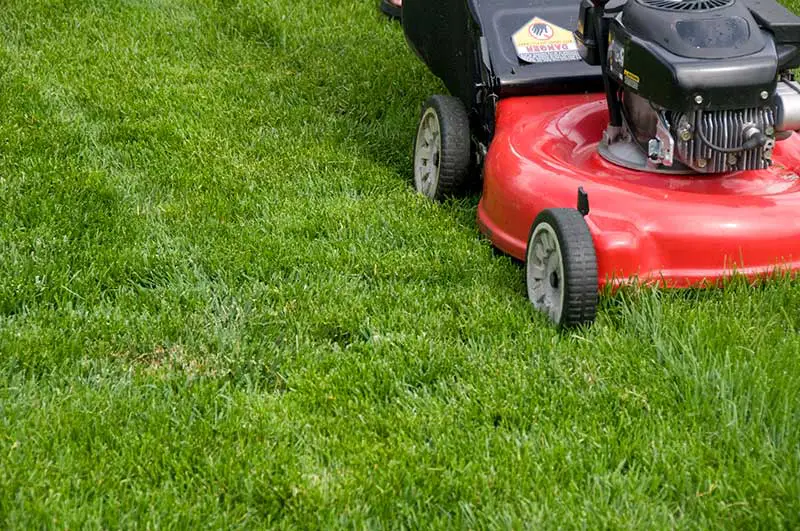
Mowing Technique For Striping Your Lawn
The impressiveness of your striping will come down to your mowing technique and accuracy. We also have some tips for you on how to maintain straight lines and get those fancy patterns!
The key to striping your lawn is mowing direction and the ability to keep straight lines unless you are going after a wavy effect!
The mowing direction is important because this aspect of mowing creates the alternate striping in the lawn with which you can get creative to create interesting patterns.
To illustrate this, we will show how to create the classic straight-line striping on your lawn.
- Start on a straight edge of your lawn and mow down the entire length of the lawn in one go.
- When you reach the end of the lawn, lift the mower and mow an adjacent strip to the one you just mowed but coming back in the opposite direction.
- When you are back where you started, lift the mower and position it to mow a strip of lawn adjacent to the one you have just mowed, but you will mow in the same direction as your first strip.
- Make sure you mow straight to avoid missing patches of grass the will appear longer than the cut grass.
- Repeat this process until the entire lawn has been mowed in alternating direction strips.
The lawnmower will push the grass over in the direction of the cut, exposing either the bright side of the grass blades or the dull side, producing the striping effect.
You can get quite creative with the patterns your can mow into your grass, the complexity of which will depend on your imagination and the time you have available to spend mowing your grass.
Mowing Tips For Lawn Striping
Some tips and techniques are useful when mowing stripes into your lawn and can help improve the final finish of your patterns.
The main challenge in lawn striping is to keep your mowing straight and on course to prevent missing out spots and creating uneven lines.
- Use a straight edge to establish the first stripe. A straight edge such as the border of a pathway, the sidewalk, driveway, or the wall of your house can act as a point of reference guideline to make sure your first stripe is straight and true. After that, you can use the previous stripe as the guideline to keep your lines straight.
- Look 10-feet ahead. Never look directly down when you are attempting to mow stripes on your lawn. It is too easy to deviate off course and ruin your design. Look about 10-feet ahead of the mower, which allows you to have a broader perspective field of view and keep a straighter line.
- Cut the grass when it is dry. Do not cut the grass when it is wet with dew or if it has been freshly watered. The mowing becomes harder, and the wet grass will clog up the mower limiting the effectiveness in pushing the grass over.
- Use a clippings box. A clippings box on your mower is needed to prevent grass clippings from lying on your lawn. Grass clippings look untidy and will cause the lawn under the clippings to turn yellow from lack of sunshine. Empty the clipping box regularly to prevent it from reducing the mower’s efficiency and from making the mower harder to keep straight.
Is A Roller Necessary For Lawn Striping?
A roller is not necessary for lawn striping, but it does bring a better definition to the pattern and make the striping last longer.
Separate rollers can be used and can be hired from garden services, but it doubles the amount of work you need to do. You will have to go over the lawn once with the mower and then repeat the process with the roller, maintaining the same direction your went with the mower.
If you do not have a roller, you can get roller attachments for lawnmowers which will flatten the grass behind the lawnmower in the direction of mowing. If you are DIY inclined, you could possibly rig up something behind your mower that will flatten the grass without damaging it.
Some mowers come with integrated rollers at the back of the machine and work well for this purpose. A mower with a split rear-roller is the ideal model to look for as it makes negotiating tight turns and corners much easier.
Conclusion
Striping a lawn is not difficult and can be done with minimal tools. Even a normal lawn mower will give visible results, but a mower with an integrated rear roller will produce even better results.
Mowing a lawn can be a tedious task, but adding some creativity to the chore can bring some additional visual rewards to an otherwise boring, mindless task!
So next time you need to mow the lawn, take a little time to plan out a pattern and try your hand at some creative striping for your lawn!

